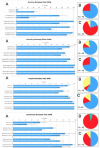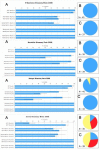Insecticide resistance in Anopheles gambiae: data from the first year of a multi-country study highlight the extent of the problem
- PMID: 20015411
- PMCID: PMC2804687
- DOI: 10.1186/1475-2875-8-299
Insecticide resistance in Anopheles gambiae: data from the first year of a multi-country study highlight the extent of the problem
Abstract
Background: Insecticide resistance in malaria vectors is a growing concern in many countries which requires immediate attention because of the limited chemical arsenal available for vector control. The current extent and distribution of this resistance in many parts of the continent is unknown and yet such information is essential for the planning of effective malaria control interventions.
Methods: In 2008, a network was established, with financial support from WHO/TDR, to investigate the extent of insecticide resistance in malaria vectors in five African countries. Here, the results of bioassays on Anopheles gambiae sensu lato from two rounds of monitoring from 12 sentinel sites in three of the partner countries are reported.
Results: Resistance is very heterogeneous even over relatively small distances. Furthermore, in some sites, large differences in mortality rates were observed during the course of the malaria transmission season. Using WHO diagnostic doses, all populations from Burkina Faso and Chad and two of the four populations from Sudan were classified as resistant to permethrin and/or deltamethrin. Very high frequencies of DDT resistance were found in urban areas in Burkina Faso and Sudan and in a cotton-growing district in Chad. In areas where both An. gambiae s.s. and Anopheles arabiensis were present, resistance was found in both species, although generally at a higher frequency in An gambiae s.s. Anopheles gambiae s.l. remains largely susceptible to the organophosphate fenitrothion and the carbamate bendiocarb in the majority of the sentinel sites with the exception of two sites in Burkina Faso. In the cotton-growing region of Soumousso in Burkina Faso, the vector population is resistant to all four classes of insecticide available for malaria control.
Conclusions: Possible factors influencing the frequency of resistant individuals observed in the sentinel sites are discussed. The results of this study highlight the importance of standardized longitudinal insecticide resistance monitoring and the urgent need for studies to monitor the impact of this resistance on malaria vector control activities.
Figures




References
-
- WHO Pesticide Evaluation Scheme. http://www.who.int/whopes/en/
-
- Hamon J, Subra R, Sales S, Coz J. Presence in the southwestern part of Upper Volta of a population of Anopheles gambiae "A" resistant to DDT. Med Trop (Mars) 1968;28:521–528. - PubMed
-
- Elissa N, Mouchet J, Riviere F, Meunier JY, Yao K. Resistance of Anopheles gambiae s.s. to pyrethroids in Cote d'Ivoire. Ann Soc Belg Med Trop. 1993;73:291–294. - PubMed
Publication types
MeSH terms
Substances
LinkOut - more resources
Full Text Sources
Miscellaneous

